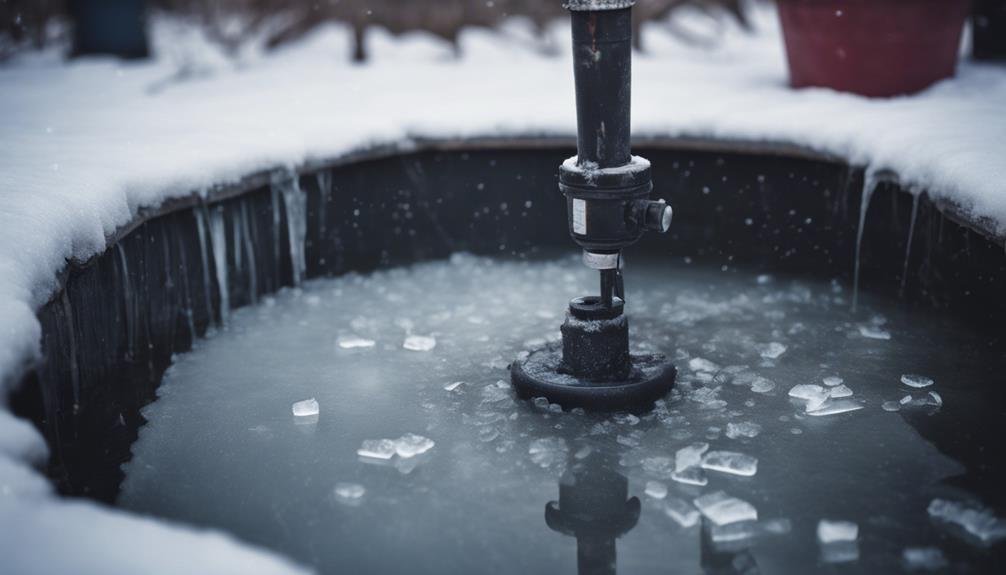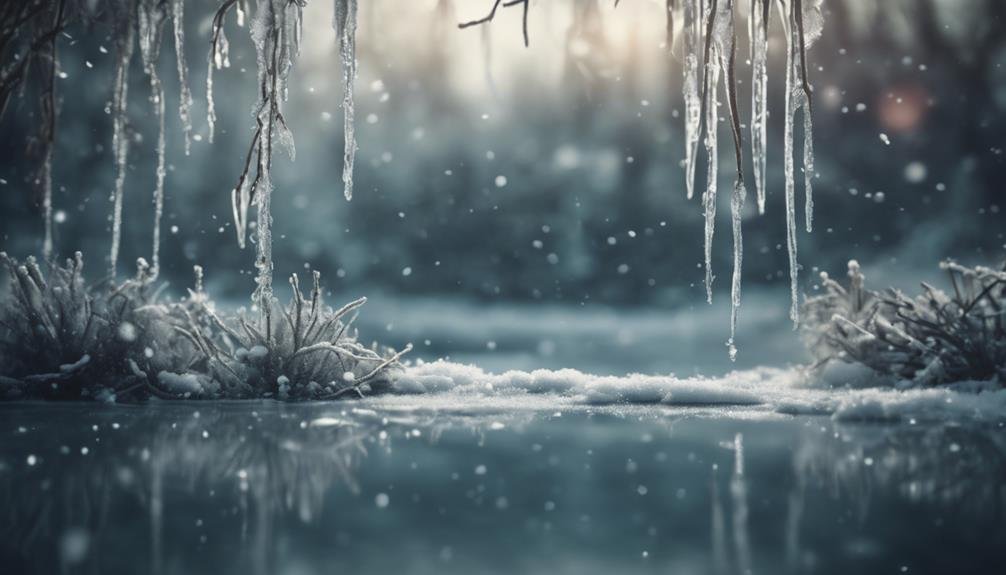In order to address common issues that arise in winter ponds, we will utilize de-icing methods such as pond heaters or aerators to prevent the surface from freezing over.
It is crucial to maintain good water quality by conducting partial water changes, monitoring pH levels, and regularly testing the water chemistry.
Regular equipment checks are important to spot any pump or filter malfunctions or blockages.
Taking care of fish involves ensuring they have enough oxygen, feeding them high-quality food, and keeping an eye out for any spikes in ammonia or nitrite levels.
When it comes to plants, removing decaying material, providing insulation, and ensuring proper water circulation are key tasks.
Being proactive in caring for your pond will help safeguard the ecosystem during the harsh winter conditions.
Explore more detailed winter care strategies to keep your pond healthy and thriving.
De-icing Techniques
To ensure our pond remains partially ice-free during winter, allowing for gas exchange and preventing fish kills, we can utilize different de-icing techniques. One effective method is installing a pond de-icer, a submersible unit that circulates warm water from the bottom to the surface, preventing ice formation over a small area.
Alternatively, a floating pond heater placed on the water's surface can melt a hole in the ice, facilitating gas exchange. Another option is employing an aeration system that introduces air bubbles into the water, preventing complete freezing.
Manual ice removal by breaking it or using a hot water de-icer is also possible, but it's essential to leave some ice cover to protect the pond's ecosystem from extreme cold. Regularly checking the de-icing system's functionality and making adjustments as needed is crucial to ensure the pond's health throughout the winter.
Maintaining Water Quality
Maintaining water quality during winter is crucial as low temperatures can hinder natural processes that keep the water clean. To prevent a build-up of debris and excess nutrients, regular partial water changes are necessary. Replacing 10-15% of the pond volume every few weeks with fresh, dechlorinated water helps maintain a healthy balance.
Monitoring water chemistry levels is equally important. Testing the water frequently and adjusting pH levels within the range of 6.5-8.5 is essential. High levels of ammonia and nitrite can harm fish, so investing in quality test kits and following instructions diligently is key.
Balancing beneficial bacteria, plants, and fish populations is vital for a thriving ecosystem. Avoid overstocking and overfeeding to prevent water quality issues.
Inspecting Equipment Regularly

To maintain proper water quality in winter, it's crucial to regularly inspect all pond equipment for any signs of malfunction. This includes checking the pump, filter, skimmer, and other mechanical systems for clogs, leaks, or unusual noises that could indicate issues. Ensuring these components are operating correctly is essential for the overall health of the pond.
It is also important to inspect the pond's aerator or de-icer to prevent complete freezing. These devices facilitate gas exchange, which is vital for the pond's ecosystem. Checking that they're properly positioned and free of obstructions is key to their effectiveness.
Furthermore, examining the pond's electrical components, such as the lighting system and heating elements, is necessary. Look out for frayed wires, loose connections, or any signs of damage to prevent potential hazards and ensure safe and efficient operation.
Regular maintenance and inspections help to keep the pond functioning optimally throughout the winter months.
Protecting Fish Population
Protecting fish during winter in ponds is crucial for their well-being. To ensure their survival in the cold months, consider these three important steps:
First, it's vital to maintain sufficient oxygen levels in the water. This can be achieved by creating openings in the ice surface using a de-icer or manually. Without enough oxygen, fish can suffocate.
Second, provide fish with supplemental feeding using high-quality, low-protein fish food. In winter, their metabolism slows down, so it's important to avoid overfeeding.
Lastly, regularly monitor the water quality by testing for levels of ammonia, nitrite, and pH. If these parameters are unfavorable, partial water changes may be necessary to keep the environment healthy for the fish.
Preventing Plant Damage

Protecting aquatic plants in ponds during winter is crucial for maintaining their health and the overall balance of the ecosystem. To prevent plant damage, it's essential to remove decaying plant material before the pond freezes. This helps prevent the release of harmful gases and avoids oxygen depletion, which can harm fish.
Ensuring proper water flow and aeration is another key step in protecting aquatic plants. Stagnant water can lead to the accumulation of toxins and low oxygen levels, causing stress to the plants. Using a pond de-icer or an aeration system can help keep a portion of the pond's surface ice-free, allowing for gas exchange and preventing stagnation.
In cases where the pond is at risk of complete freezing, adding a floating insulation blanket or covering part of it with a greenhouse-style structure can provide protection. These measures help maintain a stable water temperature, safeguarding plants from the harsh winter conditions.
Conclusion
By taking proactive measures such as de-icing, maintaining water quality, inspecting equipment, protecting fish, and caring for plants, we can ensure that the majority of backyard ponds, about 90%, stay healthy despite the challenges of winter. These steps are crucial in safeguarding our beloved water features, allowing us to appreciate their beauty throughout the year without any issues or damage.
Proper de-icing helps prevent the formation of ice that can harm aquatic life and damage equipment. Maintaining water quality ensures a balanced ecosystem for fish and plants to thrive during the colder months. Regular equipment inspections help identify and address any issues before they escalate. Protecting fish from harsh winter conditions is essential for their well-being, while proper plant care contributes to the overall health of the pond.
For example, using a pond de-icer can help maintain an opening in the ice to allow for gas exchange and prevent the build-up of harmful gases. Adding beneficial bacteria to the water can help break down organic matter and reduce nutrient levels, improving water quality. Inspecting pumps, filters, and other equipment for any signs of damage or malfunction is key to ensuring their efficient operation.
By following these preventative steps and investing time in winter pond care, we can enjoy our ponds year-round with peace of mind, knowing that they're well-maintained and protected from the challenges of the season.

